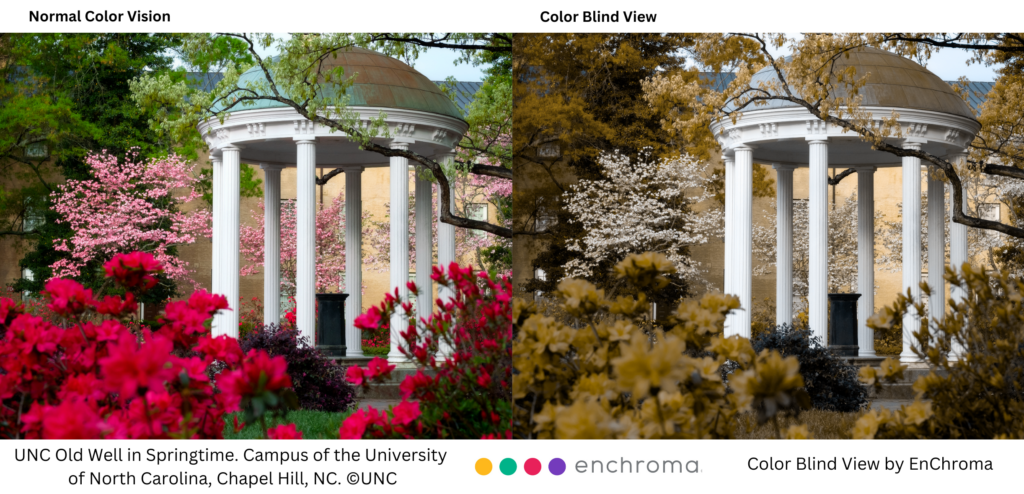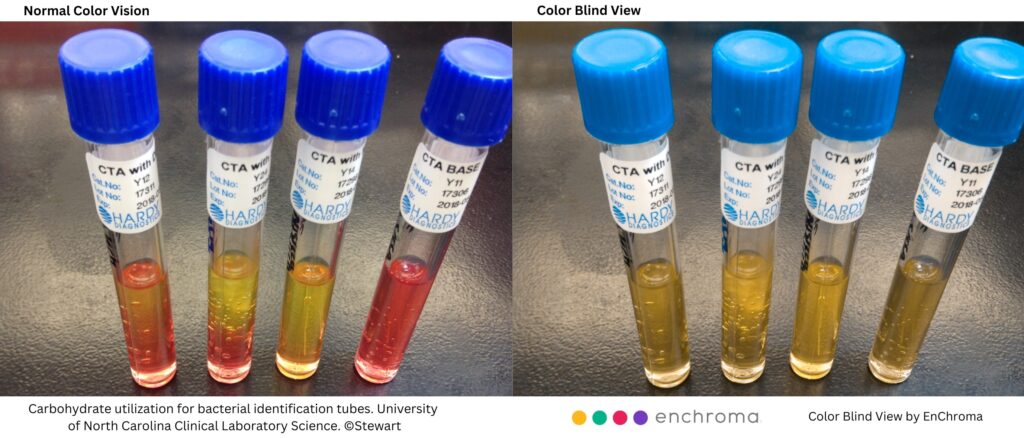On April 25, EnChroma officially announced its partnership with The University of North Carolina at Chapel Hill, an effort and outcome spearheaded by Clinical Laboratory Science (CLS) assistant professor Laine Stewart, MLS.
EnChroma creates glasses for color blindness and partners with universities across the country to bring glasses to educational settings through its Color Accessibility Program for Education. Stewart happened across the program in the fall of 2022 while researching potential solutions for a color-blind student in one of her classes. She had taught color-blind students in the past but wondered if there was any opportunity to make life a bit easier for them in the already rigorous CLS program.
Defining Color Blindness
According to EnChroma’s research, one in 12 men (8%) and one in 200 women (0.5%) are color blind – 13 million in the U.S., 30 million in Europe, and 350 million worldwide. With a total student population of 31,593 and 13,108 faculty and staff, based on national trends roughly 1,343 students may be color blind along with 557 faculty and staff at UNC-Chapel Hill. Within the Department of Health Sciences’ student population of approximately 400, the statistics would indicate about 17 students are color blind.
While people with normal color vision see more than one million shades of color, the color blind only see an estimated 10 percent of hues and shades. Common color confusions include green and yellow, gray and pink, purple and blue, and red and brown. These colors often appear muted and dull and can be difficult to tell apart.
“The color-blind students I have taught in the Clinical Laboratory Science program have all been highly capable but were at a decided disadvantage when learning to read biochemical reactions involving color or identifying cellular characteristics under the microscope using polychromatic stains,” said Stewart. “Seeing how these reactions and cells likely appeared to them using a color-blind simulator makes me amazed at what they had to overcome.”

Challenges with Color in CLS
Stewart’s student, Trent Biggers, did not know he was color blind until he was a teenager. His older brother initially discovered his own color blindness when he applied to enter the military, which prompted Biggers to be tested as well. During his education prior to joining the CLS program, Biggers’s color blindness did not cause many issues – maybe the occasional slight confusion on colors on a PowerPoint presentation, but nothing that would negatively impact his career path.
However, once he shifted his focus to pursuing a CLS degree, Biggers’s colorblindness became a constant obstacle. “It was an eye-opening experience in the program and I had to come up with my own roadmap when it came to figuring out new areas in the lab, like micro,” said Biggers. “It was a struggle, and I spent lots of time asking questions and clarifying things with my professors. Instead of it being a low-profile thing that I just happen to have, I was confronting my color blindness daily as I learned how to work within my chosen profession.”
Biggers persevered with the help of his instructors and secured a job months before he was set to graduate. But, when his supervisor learned he was color blind,Biggers had to take multiple color blindness tests to ensure he could keep his job. “I understand the concern, because it is scary to consider how my color blindness could affect patient care,” said Biggers. “However, when I first began interviewing with my employer, they didn’t know EnChroma glasses existed. The glasses should help me pass the qualification testing for my job and support me in my day-to-day role in the lab.”
EnChroma Kickoff for UNC Students and Faculty
Thanks to Stewart’s outreach to EnChroma and ensuing partnership, Biggers was gifted a pair of EnChroma color blind glasses to use in his day-to-day. He tried the glasses for the first time alongside two other Department of Health Sciences students and one UNC faculty at a kickoff event on April 25. Biggers and his peers spent nearly an hour using their new glasses to take in the details of UNC’s central campus, including red brick walkways, spring flowers, painted banners and even their own clothing.
Since then, Biggers has been wearing the glasses more often to allow his eyes and brain to adjust to the color changes. Just before his graduation in May, he joined Stewart in the CLS student laboratory to give the glasses a spin while viewing colorful cultures and samples in the microscope.
“When I wear the glasses it’s surprising to see new pops of color – red, for example,” said Biggers. “I look forward to experimenting more with the glasses while I’m in the lab. I want to see if there are things I didn’t even know I couldn’t do, that I can do now.”
Color Accessibility for UNC’s Campus
Stewart’s work to support her student manifested into an opportunity to bring EnChroma glasses to the entirety of UNC’s campus. Though the kickoff event participants each received his or her own pair of glasses, multiple pairs for indoor and outdoor use are now available to check out through UNC Libraries – students, faculty and staff can access the glasses at the Health Sciences Library and Davis Library.
“I am excited to have EnChroma glasses available to offer to future students with color vision deficiencies to make Clinical Laboratory Science more accessible to them and make their learning experience more equitable,” said Stewart.
